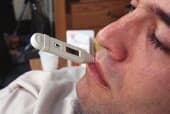This flu strain tends to hit younger adults harder than older adults, CDC says
WebMD News from HealthDay

By Steven Reinberg
HealthDay Reporter
THURSDAY, Dec. 26, 2013 (HealthDay News) -- This year's flu season may be off to a slow start nationwide, but infection rates are spiking in the south-central United States, where five deaths have already been reported in Texas.
And the predominant strain of flu so far has been H1N1 "swine" flu, which triggered the pandemic flu in 2009, federal health officials said Thursday.
"That may change, but right now most of the flu is H1N1," said Dr. Michael Young, a medical officer with the U.S. Centers for Disease Control and Prevention's influenza division. "It's the same H1N1 we have been seeing the past couple of years and that we really started to see in 2009 during the pandemic."
States reporting increasing levels of flu activity include Alabama, Louisiana, Mississippi and Texas, he said.
Young noted that H1N1 flu is different from other types of flu because it tends to strike younger adults harder than older adults. Flu is typically a bigger threat to people 65 and older and very young children and people with chronic medical conditions, such as heart disease and diabetes, he said.
"This year, because it's an H1N1 season so far, we are seeing more infections in younger adults," Young said. "And some of these folks have underlying conditions that put them at risk for hospitalization or death. This may be surprising to some folks, because they forget the population that H1N1 hits."
The good news, Young said, is that this year's flu vaccine protects against the H1N1 flu. "For people who aren't vaccinated yet, there's still time -- they should go out and get their vaccine," he advised.
Flu activity is expected to increase nationwide during the next several weeks, Young pointed out. "We usually see flu activity peak in January and February," he said.
The CDC recommends that everyone 6 months of age and older be vaccinated against the flu.
Over the 30 years from 1976 to 2006, estimates of deaths from all strains of flu in the United States ranged from a low of about 3,000 to a high of about 49,000 people, according to the CDC.
Young said it's doubtful that the H1N1 flu will reach a pandemic level like in 2009. There are several reasons for optimism, he noted.
First, millions of people have already been vaccinated against H1N1 flu, and millions of others have been exposed to it since 2009, he said.
In 2009, the new type of H1N1 flu appeared in the United States for the first time, according to health officials.
For a flu strain like H1N1 to become pandemic it has to "find a group of people that has never seen anything like it before. We don't have that population anymore," he added.
source : H1N1 Flu Spreading in South-Central U.S.








